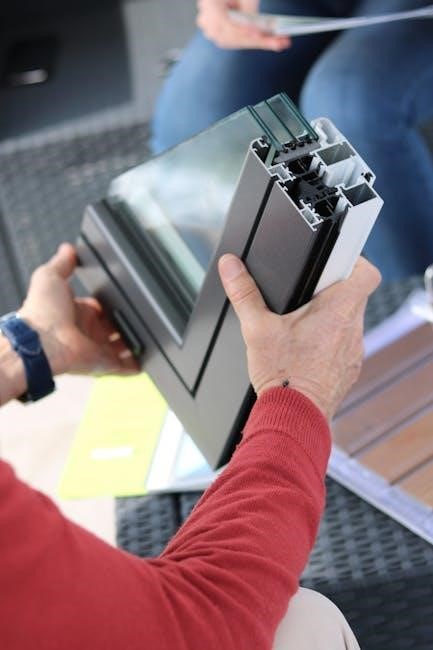xnx xnx transmitter installation manual 2022
Welcome to the XNX Transmitter Installation Manual 2022. This guide provides comprehensive instructions for installing, configuring, and maintaining the Honeywell XNX Universal Transmitter. Designed for safety and efficiency, it covers essential steps and best practices to ensure proper setup and operation of the device.
1.1 Purpose of the Manual
The purpose of the XNX Transmitter Installation Manual 2022 is to provide clear, step-by-step instructions for the safe and effective installation, configuration, and maintenance of the Honeywell XNX Universal Transmitter. This manual is designed to ensure users understand the device’s features, comply with safety standards, and perform operations correctly. It serves as a comprehensive resource for technicians, engineers, and operators, covering all aspects of the transmitter’s setup and operation to guarantee optimal performance and reliability in hazardous environments.
1.2 Scope of the Document
This manual covers the installation, configuration, and maintenance of the Honeywell XNX Universal Transmitter, ensuring safe and proper operation. It includes detailed instructions for mounting, wiring, and calibrating the device, as well as troubleshooting common issues. The document also outlines safety precautions, compliance with international standards, and environmental considerations. Intended for technicians and engineers, it provides a thorough understanding of the transmitter’s features and operational requirements, ensuring optimal performance in hazardous areas. Adherence to this guide is essential for reliable and compliant deployment of the XNX Universal Transmitter.
1.3 Target Audience
This manual is designed for professionals responsible for installing, configuring, and maintaining the Honeywell XNX Universal Transmitter. It is intended for system engineers, technicians, and safety officers working in industrial settings. The guide assumes a basic understanding of gas detection systems and electrical installations. It provides detailed instructions and safety protocols to ensure the transmitter operates effectively in hazardous environments. By following this manual, users can achieve compliant and efficient deployment of the XNX Universal Transmitter, optimizing its performance and ensuring workplace safety.

Safety Information and Precautions
This section outlines critical safety measures for installing and operating the XNX Universal Transmitter. Adherence to these guidelines ensures compliance with international standards and prevents hazards in hazardous areas.
2.1 General Safety Warnings
Read and understand this manual before installing, operating, or maintaining the XNX Universal Transmitter. Ensure all safety precautions are followed to prevent hazards. Installation must comply with recognized international standards and local regulations. Avoid improper modifications, as they may void certifications or cause malfunctions. Always use approved components and follow proper grounding procedures. Failure to adhere to these warnings may result in injury, equipment damage, or non-compliance with safety regulations. Proper training and adherence to safety protocols are essential for safe operation in hazardous environments.
2.2 Hazardous Area Classifications
The XNX Universal Transmitter is certified for use in hazardous areas classified as Class 1 or Class 2 environments. It meets intrinsic safety and explosion-proof requirements, ensuring safe operation in oil, chemical, and other industries. Proper installation in these areas must comply with local and international regulations. The device supports a wide range of sensors and communication options while maintaining safety standards. Always verify the classification of the area before installation to ensure compliance and safe operation of the transmitter in potentially hazardous environments.
2.3 Compliance with International Standards
The XNX Universal Transmitter is designed to meet rigorous international safety standards, including ATEX, IECEx, CSA, and UL certifications. It ensures compliance with global regulations for hazardous area equipment. The transmitter is certified for intrinsic safety and explosion-proof protection, making it suitable for Class 1 and Class 2 environments. Adherence to these standards guarantees safe and reliable operation in various industrial settings worldwide. Always verify local regulations and ensure installation meets compliance requirements to maintain safety and performance in hazardous environments.
Product Overview
The XNX Universal Transmitter offers a versatile, low-maintenance platform supporting various sensor types and communication options, ideal for hazardous area gas detection applications.
3.1 Features of the XNX Universal Transmitter
The XNX Universal Transmitter is a versatile, low-maintenance device designed for gas detection systems. It supports multiple sensor types, including electrochemical, infrared, and catalytic bead sensors. The transmitter features modular inputs and outputs, offering flexibility in system configuration. It supports communication protocols like HART, Modbus, and Foundation Fieldbus, enabling seamless integration with control systems. Certified for hazardous areas, the XNX transmitter meets global safety standards, ensuring reliable operation in harsh environments. Its universal platform simplifies installation and maintenance, making it a cost-effective solution for industrial gas detection applications.
3.2 Supported Sensor Types
The XNX Universal Transmitter supports a wide range of sensor types, including electrochemical, infrared, and catalytic bead sensors. It is compatible with Honeywell’s Sensepoint Optima Plus, Searchline Excel, and other gas detection sensors. This versatility allows the transmitter to be used in various industrial applications, ensuring accurate gas detection and measurement. The device’s modular design enables easy integration of different sensors, making it adaptable to specific monitoring needs. This flexibility enhances its functionality across multiple industries, providing reliable performance in hazardous environments.
3.3 Communication Options (Modbus, HART, etc.)
The XNX Universal Transmitter offers multiple communication options, including Modbus, HART, and Foundation Fieldbus. These protocols enable seamless integration with control systems, enhancing data accessibility and system monitoring. Modbus provides a cost-effective solution for basic communication needs, while HART allows for advanced configuration and diagnostic capabilities. Foundation Fieldbus supports complex process control applications. The transmitter also includes optional communication boards, such as relay and Modbus, ensuring compatibility with various industrial communication standards. This flexibility makes the XNX suitable for diverse industrial environments, meeting specific communication requirements efficiently.

Pre-Installation Checks
Before installing the XNX Universal Transmitter, ensure all components are unpacked and inspected for damage. Verify power supply compatibility, sensor compatibility, and environmental conditions meet specifications.
4.1 Unpacking and Inspection
Carefully unpack the XNX Universal Transmitter and inspect for any visible damage. Verify all components, including the transmitter, sensors, and accessories, are included. Ensure the device is handled with care to avoid damage. Check for signs of tampering or wear. If any issues are found, contact Honeywell support immediately. Refer to the packing list to confirm all items are accounted for. This step ensures a smooth installation process and prevents potential operational issues later. Proper inspection is critical for maintaining warranty validity and ensuring safety standards are met.
4.2 Tools and Materials Required
To install the XNX Universal Transmitter, ensure you have the necessary tools and materials. These include a screwdriver, wrench, pliers, and wire strippers for wiring and connections. Additionally, mounting hardware such as screws, brackets, and optional pipe mount kits may be required. Anti-seize compound is recommended for threaded connections to prevent corrosion; A multimeter can be useful for verifying power supply and communication wiring. Ensure all materials meet the environmental and safety standards specified in the manual. Proper preparation of tools and materials is essential for a safe and successful installation process.
4.3 Environmental Considerations
Ensure the XNX Universal Transmitter is installed in environments within its operating specifications. The device operates effectively in temperatures ranging from -40°C to 60°C (-40°F to 140°F) and up to 95% non-condensing humidity. Avoid exposure to corrosive substances, extreme vibrations, or direct sunlight. In hazardous areas, ensure compliance with explosion-proof and intrinsic safety standards. Use protective measures like anti-seize compound on threaded connections to prevent corrosion. Properly seal the housing to maintain IP ratings. Always verify local regulations and environmental conditions before installation to ensure optimal performance and longevity of the transmitter.

Mounting the XNX Universal Transmitter
The XNX Universal Transmitter can be mounted on a flat wall, Unistrut, or pipe using integral mounting tabs or an optional Pipe Mount Kit for flexibility and compliance.
5.1 Mounting Methods (Wall, Unistrut, Pipe)
The XNX Universal Transmitter offers flexible mounting options to suit various applications. It can be securely attached to a flat wall, Unistrut, or pipe using integral mounting tabs. For pipe mounting, an optional Pipe Mount Kit is available, supporting pipes with diameters from 2 to 6 inches (50 to 150mm). This versatility ensures the transmitter can be installed in diverse environments while maintaining stability and compliance with safety standards. Proper alignment and torque specifications must be followed for a secure installation.
5.2 Optional Pipe Mount Kit Instructions
The Optional Pipe Mount Kit allows the XNX Universal Transmitter to be securely mounted to pipes with diameters from 2 to 6 inches (50 to 150mm). To install, attach the mounting bracket to the pipe using the provided hardware. Ensure the bracket is tightened evenly to avoid misalignment. Next, align the transmitter’s mounting tabs with the bracket and secure it using the recommended torque specifications (refer to the manual for details). This method provides a sturdy and reliable installation in industrial environments. Always consult the manual for specific diagrams and additional tips to ensure a proper fit.
5.3 Remote Mounting Options
The XNX Universal Transmitter supports remote mounting, offering flexibility for installations where the transmitter needs to be located away from the sensor. This is particularly useful in hazardous areas or when space is limited. The remote sensor can be mounted up to 100 feet (30 meters) away from the transmitter using an approved cable. Ensure the cable is properly sealed and routed to maintain the integrity of hazardous area certifications. Refer to the manual for specific guidelines on remote mounting configurations and wiring requirements to ensure safe and reliable operation. Always follow local regulations and safety standards during installation.

Wiring and Connections
Ensure proper wiring and connections for the XNX Universal Transmitter, including power supply, sensor, and communication cables. Follow guidelines for Modbus, HART, and other communication protocols.
6.1 Power Supply Requirements
The XNX Universal Transmitter requires a power supply of 16 to 32 VDC for EC and mV versions. For models like the Searchpoint Optima Plus, the range is 18 to 32 VDC. Ensure the power source meets these specifications to avoid malfunctions. Always comply with hazardous area classifications and international standards when connecting the power supply. Refer to the technical manual for detailed voltage requirements and wiring guidelines to ensure safe and proper installation.
6.2 Sensor and Option Board Connections
Connect the sensor to the XNX Universal Transmitter by aligning the pins and securing it firmly. Install the option board by inserting its pins into the main board connector. Ensure all connections are tight to prevent signal loss. After connecting, slide the POD back into the housing and replace the cover, applying anti-seize compound to threads for corrosion protection. Refer to the manual for specific wiring diagrams and instructions tailored to your sensor type, such as electrochemical or infrared models.
6.3 Communication Wiring (Modbus, HART)
For Modbus communication, connect the transmitter using RS485 twisted-pair cables. Ensure proper termination at both ends to avoid signal interference. For HART communication, use a two-wire loop to connect the transmitter to the control system. Verify wiring polarity and follow the provided diagrams for accurate connections. Configure communication settings via the transmitter’s interface or external software. Always consult the manual for specific wiring instructions and compatibility checks to ensure reliable data transmission and system integration.

Configuring the Transmitter
Configure the XNX Transmitter by setting gas type, range, and alarm levels. Follow the manual for proper setup and safe operation of the device.
7.1 Initial Setup and Configuration
Begin by installing the option board and connecting the sensor. Set the gas type, range, and alarm levels according to the application requirements. Power up the transmitter and verify communication settings. Ensure all configurations align with the device’s intended use and environmental conditions. Refer to the manual for detailed procedures and safety guidelines. Proper initial setup ensures accurate performance and reliability of the XNX Transmitter in hazardous area monitoring applications.
7.2 Setting Gas Type and Range
Select the appropriate gas type from the transmitter’s menu to ensure compatibility with the installed sensor. Configure the measurement range according to the application’s requirements, ensuring it aligns with the sensor’s specifications. Refer to the manual for specific gas type settings and range limitations. Proper configuration ensures accurate detection and alarm functionality. Always follow safety guidelines during setup. After configuration, test the system to confirm proper operation and accuracy. This step is critical for reliable gas monitoring and alarm responses.
7.3 Alarm Level Configuration
Configure alarm levels according to the application’s requirements and local regulations. Navigate to the alarm setup menu and set the lower and upper alarm thresholds based on the gas type and range configured earlier. Ensure the alarm levels align with the sensor’s capabilities and the facility’s safety protocols. After setting, perform a test to verify that alarms activate correctly. Refer to the manual for specific instructions on alarm configuration and testing procedures. Properly configured alarm levels are critical for ensuring timely alerts and maintaining safety in hazardous environments. Always follow safety guidelines during this process.

Calibrating the Transmitter
Calibrate the XNX transmitter using zero and span adjustments to ensure accurate gas detection. Follow the manual’s guidelines for precise setup and reliable performance.
8.1 Calibration Procedures
Calibration is critical for ensuring accurate gas detection. Begin by preparing the transmitter according to the manual’s guidelines. Use calibration gas to set the zero and span adjustments, ensuring the device reads correctly. Access the LCD menu or HART interface to input values. Perform a zero calibration in fresh air and span calibration using the target gas. After adjustments, cycle power to confirm settings. Document all results for future reference and ensure compliance with safety protocols throughout the process.
8.2 Zero and Span Adjustment
Zero and span adjustments are essential for accurate gas detection. Begin by exposing the sensor to zero gas (fresh air) and adjust the zero potentiometer until the reading stabilizes at 0%. Next, introduce the target gas at the maximum concentration and adjust the span potentiometer to achieve the correct reading. Use the HART interface or LCD menu for precise adjustments. After completing, cycle power to ensure settings are retained. Always follow safety guidelines and refer to the manual for specific gas types and ranges to ensure optimal performance and accuracy. Proper adjustment ensures reliable operation.
8.3 Verification and Testing
After calibration, verify the transmitter’s accuracy by exposing the sensor to zero and span gases. Use a digital multimeter to ensure the output signal matches the expected 4-20mA range. Perform a functional test of alarms and communication interfaces. Cycle power to confirm settings are retained. Document all test results for future reference and compliance. Ensure all safety protocols are followed during testing. If discrepancies are found, repeat the calibration process. Successful verification ensures reliable operation and compliance with safety standards. Always refer to the manual for specific test procedures and expectations. Proper testing guarantees accurate and safe performance.

Startup and Initialization
Power up the transmitter and verify the 4-20mA output. Perform system initialization checks to ensure all components function correctly. The transmitter is now ready for operation.
9.1 Power-Up Sequence
Connect the power supply to the transmitter, ensuring the voltage matches the required range (16-32 VDC for most models). Turn on the power and observe the LED indicators. The system will perform a self-test, checking internal circuits and communication interfaces. Verify that all LEDs indicate normal operation. If any errors are detected, refer to the troubleshooting section. Once the self-test completes successfully, the transmitter is ready for configuration and initialization. Ensure all sensors and communication devices are properly connected before proceeding. This step is critical for ensuring accurate gas detection and reliable performance. Always follow safety guidelines during power-up.
9.2 System Initialization Checks
After powering up, perform a series of system checks to ensure proper functionality. Verify that all sensors are detected and communicating correctly with the transmitter. Check that communication interfaces, such as Modbus or HART, are operational and configured properly. Review alarm levels and gas type settings to confirm they match the application requirements. Ensure the transmitter displays accurate gas readings and that all configured relays or outputs respond appropriately. Address any error messages or alarms promptly, consulting the troubleshooting guide if necessary. These checks are critical for ensuring reliable operation and safety. Always document the results for future reference.
9.3 Final Testing and Validation
Once initialization is complete, perform final testing to validate system performance. Test sensor accuracy by exposing the detector to known gas concentrations and verifying the transmitter’s response. Check communication interfaces to ensure data transmission is stable and accurate. Validate alarm levels by simulating gas leaks or fault conditions and confirming proper alert triggers. Review all system settings and ensure they align with application requirements. Document the results of these tests for compliance and future reference. This step ensures the transmitter operates reliably and safely in its intended environment. Always follow established safety protocols during testing.

Maintenance and Troubleshooting
Perform routine checks, clean sensors, and verify wiring connections to ensure optimal performance. For troubleshooting, identify common issues like faulty connections or software glitches and reset the transmitter if necessary.
10.1 Routine Maintenance Tasks
Regular maintenance ensures the XNX Transmitter operates reliably. Inspect sensors for cleanliness and damage, verify wiring connections for integrity, and check power supplies for stability. Replace filters as needed and update software periodically. Perform diagnostic tests to identify potential issues early. Ensure all components are tightened and free from corrosion. Document maintenance activities for future reference and compliance with safety standards. Always refer to the manual for specific procedures and guidelines to maintain optimal performance and safety.
10.2 Common Issues and Solutions
Common issues with the XNX Transmitter include sensor inaccuracy, communication errors, and wiring faults. For sensor inaccuracy, check for contamination or improper calibration. Clean or replace sensors as needed and recalibrate. Communication issues may arise from incorrect Modbus or HART settings; verify configurations and connections. Wiring problems can be resolved by inspecting for damage or corrosion and ensuring secure connections. Always refer to the manual for troubleshooting guides. Regular maintenance and diagnostics can prevent these issues. Addressing them promptly ensures reliable performance and safety.
10.3 Diagnostic Tools and Techniques
Use diagnostic tools like Honeywell’s Toolset software for real-time monitoring and configuration. Employ multimeters for wiring checks and oscilloscopes for signal analysis. Remote access via HART or Modbus enables data collection without physical intervention. Perform error code checks and self-tests to identify faults. Data logging helps track performance trends. Regular inspections of sensors and wiring ensure reliability. These tools and techniques aid in quick issue resolution, ensuring optimal transmitter operation and safety. Always follow manual guidelines for accurate diagnostics.
The XNX Transmitter Installation Manual 2022 provides a comprehensive guide for safe and effective installation, configuration, and maintenance. Follow these steps carefully to ensure optimal performance and compliance with safety standards. Proper use of diagnostic tools and adherence to guidelines will maximize reliability. Refer to additional resources for further support.
11.1 Summary of Key Steps
The XNX Transmitter Installation Manual 2022 outlines essential steps for successful installation, configuration, and maintenance. Start with pre-installation checks, including unpacking and inspecting the device. Proceed with mounting options like wall, Unistrut, or pipe installations. Next, connect power supplies and sensors, ensuring proper wiring for communication protocols like Modbus or HART. Configure the transmitter by setting gas types, ranges, and alarm levels. Calibrate the device according to specified procedures, and perform thorough testing; Regular maintenance and troubleshooting will ensure optimal performance. Always refer to the manual for detailed guidance and safety compliance.
11.2 Final Safety Reminders
Always follow the safety guidelines outlined in the manual to ensure the XNX Transmitter operates safely and efficiently. Verify that all installations comply with international standards and local regulations. Use proper wiring and connections to avoid electrical hazards. Never modify the device without authorization, as this could compromise its intrinsic safety. Conduct regular inspections and maintenance to prevent malfunctions. Ensure all personnel involved in installation or maintenance are trained and aware of potential risks. Refer to the manual for detailed safety information and compliance requirements.

References and Additional Resources
- Refer to the Honeywell XNX Technical Manual for detailed specifications and compliance information.
- Visit Honeywell’s official website for additional resources and support.
- Consult the Quick Start Guide for initial setup instructions.
- Contact Honeywell Support for troubleshooting or technical assistance.
12.1 Related Manuals and Guides
The Honeywell XNX Transmitter Installation Manual 2022 is supported by several complementary resources. The XNX Technical Manual provides detailed technical specifications and compliance information. Additionally, the Quick Start Guide offers a concise overview for initial setup. For safety-critical information, refer to the Safety Manual. Sensor-specific guides, such as the Sensepoint Optima Plus Manual and Searchline Excel Documentation, are available for specialized configurations. These resources ensure comprehensive understanding and safe operation of the XNX Universal Transmitter.
12.2 Honeywell Support and Contact Information
For assistance with the XNX Universal Transmitter, Honeywell provides dedicated support. Visit the official Honeywell website at https://automation.honeywell.com for contact details, technical support, and regional office information. Use the online contact form or call the support hotline for immediate help. Additionally, Honeywell offers email support at support@honeywell.com. Ensure to check the regional Honeywell website for localized contact information and support options tailored to your location. Honeywell’s global network is ready to assist with any inquiries or issues.
